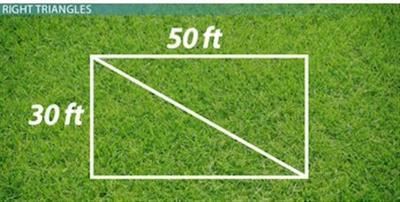Shapes
Rectangles and triangles are all around us... watching us. That's not creepy at all, right? Okay, it's a little creepy. But, they're also around us in less ominous, more friendly ways.
That field where you play soccer or football? That's a rectangle. As is everything from your cell phone to the state of Colorado. And that rack you use to set up the balls on a pool table? That's a triangle. So is the peanut butter and jelly sandwich you cut diagonally because it's more fun to eat that way. They even come in larger sizes, like the pyramids in Egypt. In this lesson, we're going to learn how to find the area of these shapes. Let's start with rectangles.
Rectangles
Let's say you're planting a garden. If your garden is 12 feet long and 4 feet wide, how big is it? This garden is a rectangle, and what you want to know is its area. The area of a rectangle is the length times the width.
So, your garden is 12 feet long by 4 feet wide. 12 is our length, and 4 is our width. 12 * 4 is 48. So, your garden is 48 square feet. Note the 'square.' That means that there are 48 one foot by one-foot squares in your garden. That's plenty of space for your vegetables!
Let's try another. Let's say you've planted your garden, and now you have an abundance of zucchini, so you're making zucchini bread - mmm, tasty. Your bread pan is 9 inches long by 5 inches wide. What is the area? Like your garden, your pan is rectangular. Ah, the circle of life. Or, a rectangle of life.
So, we want the length times width, which is 9 * 5. That's 45. So, your pan is 45 square inches. Okay, now you have to deal with all your extra peppers, cucumbers, carrots and other vegetables. You had quite a harvest. You decide to can them for the winter. You keep the jars on the shelves in your apocalypse preparedness closet (you know, just in case). If a shelf can hold 6 jars from front to back and 10 jars from left to right, and you have 300 jars (I said it was a big harvest), how many shelves will you need?
So, our rectangular shelf is 6 jars wide by 10 jars long. 6 * 10 is 60, so one shelf holds 60 jars. That's our area. But wait, we have 300 jars. How many 60-jar shelves will we need for 300 jars? Just divide 300 by 60 to get 5. So, we'll need 5 shelves.
Right Triangles
With a belly full of zucchini bread and all that canning behind us, let's talk triangles. Let's say your garden went so well you decide to branch out, so to speak, into growing and selling Christmas trees. That's ambitious of you.
You look at your remaining yard. It's 30 feet by 50 feet. So, the area of that rectangle is 30 * 50, or 1500 square feet. What if you cut it in half diagonally, like below?

The area of a triangle is 1/2 * base * height.
Now you can grow trees in one half and still have half a yard for your annual croquet tournaments.
How big is the area of the triangle you have for trees? It's half the rectangle, which was 1500 square feet. So, it's 750 square feet. Do you know what you just did? You just figured out the area formula for triangles. The area of a triangle can be defined as 1/2 * base * height or just 1/2bh. Base and height are just like length and width in a rectangle. In the right triangle above, which is a triangle with a right angle, we have half a rectangle. So, it makes sense that our formula is the same as a rectangle but cut in half.